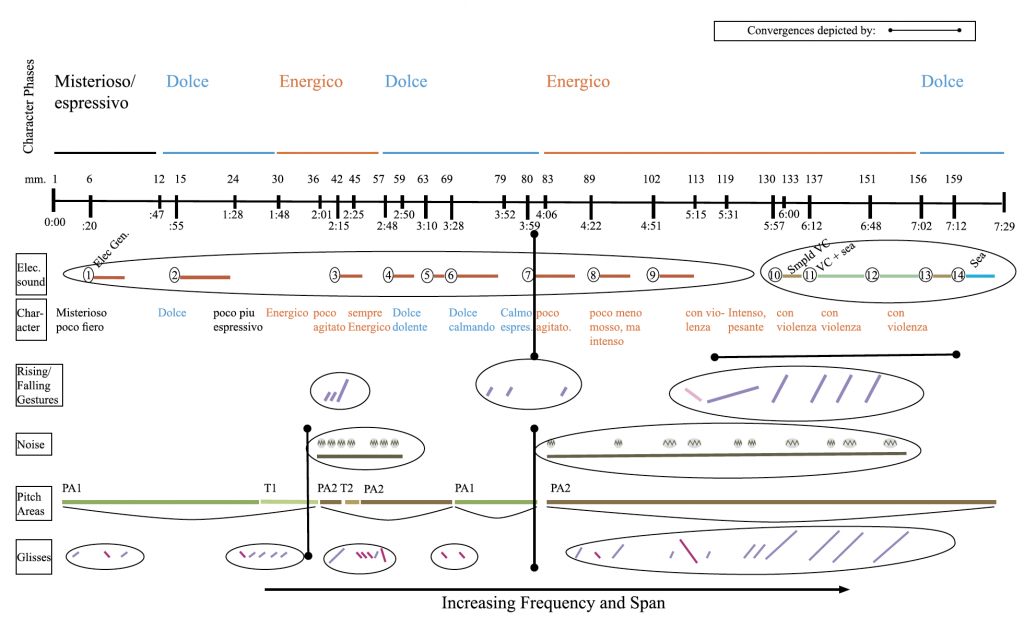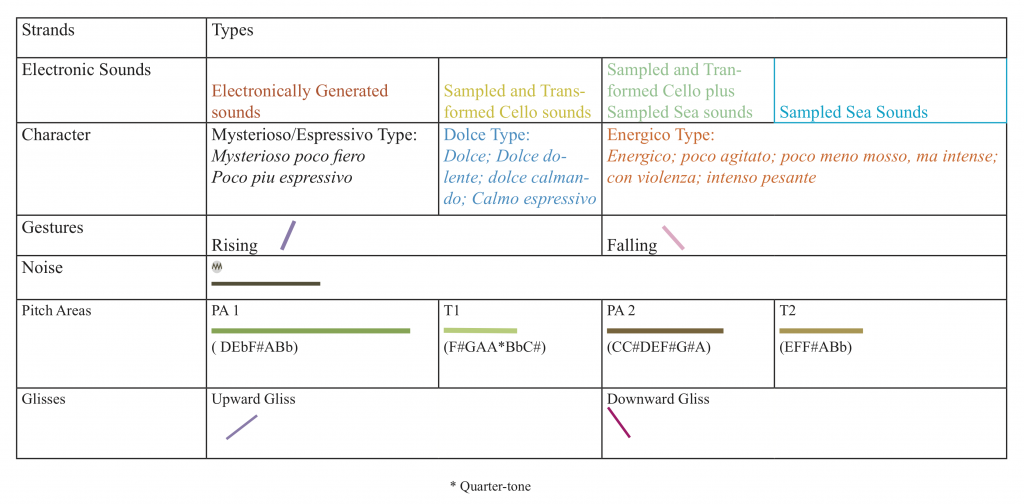Judy Lochhead
View PDFSuggested Citation
Music theory is a practice focused on conceptualizing music as a sonic and worldly phenomenon. Beyond the semantic concepts of language and the numerical representations of music’s sounding, music theorists and analysts often employ graphical modes of depicting musical structure. Music notation of the Western tradition itself operates as such a graphical representation, largely for the purposes of performance but also for music analysis. Both music notation and music theoretical and analytical forms of graphical representation accomplish a “visualizing” of musical sound. Such visualizing is a cognitive act in which some features of aurally perceived sounding are conceptualized by visually perceived graphical designs. Like any sort of modeling in the sciences or in music, visualizations are “vehicles for learning about the world” (Frigg and Hartmann 2018). The increased opportunities for digital graphical designs that emerged around the turn of the millennium have opened new possibilities for visualizing music.
The processes of visualizing things in the world that have no direct visual presence in perceptual experience have been the focus of recent research on 1) the cross-sensory modalities of experiential engagements with the world, 2) map theory in cultural geography, and 3) information visualization.1 For instance, the role of cross-sensory perception has been a central component of Arnie Cox’s embodied approach to music cognition in his Music and Embodied Cognition: Listening, Moving, Feeling, and Thinking (2016). For Cox, the processes of music cognition involve not only the “acoustic-auditory stimulus” but also the “capacities and proclivities of individuals in terms of audition (hearing), vision, and mimetic comprehension” (2016, 104). The visualization of music’s sounding, then, plays a partial role in the overall emergence of musical meaning. In cultural geography, Denis Wood observes that maps “give us . . . a reality that exceeds our vision . . .,” a reality that is “invisible or unobtainable” and that “presents us with the reality we know as differentiated from the reality we see and hear” (1992, 4–6). In other words, the visualizing of the world that maps accomplish are acts of cognition that make present the worlds we inhabit in our everyday lives. In the area of visualization, Edward Tufte has been a transformative thinker on informational graphics and their relation to cognition. In his earliest book on the topic, The Visual Display of Quantitative Information, Tufte remarks on how graphical displays “communicate information through the simultaneous presentation of words, numbers, and pictures,” all in an effort to communicate with “clarity, precision, and efficiency” (2007 [2001]). And as Tufte’s work maintains, acts of visualizing are cognitive interventions that play a role explicitly in specific public policy decisions and implicitly in cultural knowledge. For instance, consider the graphics at the website of the Climate Impact Lab: http://www.impactlab.org/. The “Impact Maps” prepared by this group, involving “economists, climate scientists, data engineers, and risk analysts,” provide the research for “decision-makers in the public and private sectors to understand the risks climate change presents and mitigate those risks through smarter investments and public policy” (impactlab.org). A crucial aspect of these climate change visualizations is how well they model the information for optimal communication to the public and policy makers.
Graphic representation of music’s sonic structure is a long-standing practice that has had relevance for performance and for music theory, analysis, and criticism. The solmization hand, often known as the Guidonian Hand, is a good example of a graphic rendering of intervals that serves as a mnemonic for performance; and more recently, the graphical display of spectral structuring of sound in a spectrogram is a visualization of aspects of sound that are given indirectly in aural perception. In the early 20th century, Heinrich Schenker famously developed a mode of music analytical visualization by blending Western music notation with other symbols deployed to show both long- and short-term relationships for musical works. In an earlier article, “Visualizing the Musical Object” (Lochhead 2006), I considered a range of different models of structural visualization: from the ethnomusicologist Sue Carol De Vale of musical texture (1985); the music theorist-composer Johann Heinichen of the circle of fifths (2000 [1711]); and the theorist-composer Robert Cogan of spectral structure (1964), among others. Similarly, Eric Isaacson, in “What You See is What You Get: On Visualizing Music” (2005), gives an overview of visualization approaches mostly developed since the mid-20th century: from Alexander Brinkman and Marco Mesiti’s (1991) formal plots to Lerdahl and Jackendoff’s (1981) hierarchical diagrams.
The visualizations in most published work on music are all in black and white, or shades of grey. While there have been good economic reasons for publishers to request black and white for diagrams, the digital medium offers many more possibilities for color and for music visualizations that incorporate animation. The move to online publications, or to books with companion websites, has spurred music scholars to develop innovative sorts of visualizations. For instance, the special issue of Music Theory Online, “Animating the Inside,” organized by John Roeder, includes several articles with animations. Music Theory Online has several instances in which authors use color and sound to model musical structures: David Blake (2012) addresses timbre in indie music using color graphics; Mark Hannaford (2017) analyzes jazz improvisations showing spectrograms and sound; and Mariusz Kozak (2015) uses color diagrams to address musical embodiment. And finally, Michael Tenzer writes about “Timbre and Polyphony in Balinese Gamelan,” using color graphics (2019), and Joshua Mailman (2019a, 2019b) uses animations to analyze texture and temporal processes in spectral music. These are just a few instances of the new formats and possibilities afforded by digital media.
Next I turn specifically to how the use of color in music visualizations opens a broader conceptual palette that enhances content. It is interesting to note how much more communicative color has become in the contemporary world of digital information. For instance, consider this recent quote by a U.S. politician. Chuck Schumer, U.S. Senator for New York, recently observed about the current practices of measuring the United States’s G.D.P.: “The government is still using a black and white television . . . We gotta catch up, so we get a more accurate picture” (quoted in Leonhardt 2019). Schumer implies here that the accuracy of information is limited by a black and white medium. Rather, nowadays color has become a powerful metaphor for the diversity of thought and a comprehensive representation of the world around us.
In his Chromophobia, the artist David Batchelor maintains that color as concept and phenomenon occupies an uncomfortable place in Western thought generally (Batchelor 2000). Not only has color been considered a secondary property, subordinate to line or form, it has resisted formalization within the framework of Western reason. As something decorative and ornamental, color is conceived as both non-essential and non-structural. Batchelor further claims that for some art critics line or form is associated with the masculine in art and color to the feminine—and hence that color has to be “contained and subordinated—like a woman” (Batchelor 2000, 23). Or in other words, color is the dangerous Other.
As a property of the visual world, color has been a challenge to conceptual understanding, but it nonetheless has effects. For example, some colors are said to be cool, others said to be hot. Such adjectives as cool and hot indicate that colors have an effect on mood, and through their associations with people, groups, or things colors may help to forge relationships or become symbols of power. One can think about the pink ribbons worn for Breast Cancer Awareness, the association of purple with royalty, and the rainbow flag as a sign of LGBTQ+ pride. In its power to affect people, color generates meaning and content even if it poses a challenge to linguistic formulation.
One of the great opportunities of digital publishing—the new online format being adopted by Intégral—is the potential to use color in graphic visualization of music. Color as one of the components of graphical design opens up not only new tools for representation but also new means of conceptualization. In my own research, I tend to visualize musical structures with digital graphic designs—always starting with color. If a particular music analysis project made its way to print, I often had to devise a way to translate what had been a color-conceived visualization into black and white. An example can demonstrate what I think to be the power of color to generate analytical content that is more directly and easily understood.
I began work on Kaija Saariaho’s Près, movement I, for cello and electronics, before deciding that it would be published in a book I was co-editing, Music’s Immanent Future (Macarthur, Lochhead, and Shaw 2016). I had first produced a color visualization of the formal processes of the first movement and then later in the process produced a black and white version. Figures 1a and 1b show the black and white version that was published in the article “Chaotic Mappings” (Lochhead 2016). Figure 1a is a key to the events that are mapped in Figure 1b. Together these two figures provide an analytical map of the events of the movement and an analysis of formal design by the concept of converging processes.


Figure 1. Chaotic Mappings. Black and White Version.
The prior version of these two figures—the key and overall formal design—uses color to show timbral types, character, and pitch areas. I had used Figures 2a and 2b when giving public presentations and they served as the basis for the black and white version.

Figure 2. Chaotic Mappings. Color Version.
It is my claim here that the analytical information about the roles of timbre, character, and pitch areas is more readily apparent in the color versions. One can easily see by color the ways these types of musical features shape overall formal design. And the immediacy of color perception makes the analytical points more transparently visible. My choice of colors is not motivated by any necessary connection between the colors and the sounding events—that is, there is no claim to a synaesthetic relation. Rather, the colors more or less correspond to associations I might have between, for instance, blue and a dolce character or orange and an energico character. At other times, however, the color choices are motivated by the goal of making an easily visual distinction.
Intégral’s decision to go to an online, digital publishing format gives music theorists and analysts more powerful options to give, in Chuck Schumer’s words, “a more accurate picture” of, in this case, music and its sounding structures. This is particularly true for those theorists and analysts who turn to music’s “tone color”—the timbral domain. Visual color provides some powerful tools to show visually tone color’s structural role in music.2
Finally, Intégral is not only going to an online, digital format for its current subscribers; it will be open-access and hence available to anyone who “wanders” across it. This availability provides a great opportunity for music scholars, perhaps unwittingly, to engage in public humanities and arts. Our analyses might become public performances of scholarship that go beyond the confines of our scholarly communities. Which brings me back to color and to the thought that maybe children and young people might wander across a colorful analysis of Saariaho’s Près. The color theorist Faber Birren, writing in his Color and Human Response, observes: “Youngsters are more responsive to color than to form and will delight in it through sheer pleasure. As they grow older and become less impulsive, as they submit to discipline, color may lose some of its intrinsic appeal” (Birren 1978, 117, quoted in Batchelor 2000, 79). Perhaps—just perhaps—a young person would find the colorful visualizations of music pleasing in some way and would become fascinated with the sounds of Saariaho’s music. And perhaps, that young person would go on to be a music scholar who develops the next generation of music visualizations. And perhaps—just perhaps—this next generation of music scholars will discover the power of color to explain and to delight.
Judy Lochhead is a music theorist and musicologist whose work focuses on the most recent musical practices in North America and Europe, with particular emphasis on music of the Western Classical tradition. Some recent and forthcoming work includes: Sound and Affect: Sound, Music, World, edited by Stephen Decatur Smith, Judy Lochhead, and Eduardo Mendieta (Forthcoming, University of Chicago Press 2021); “Music Places: Imaginative Transports of Listening,” The Oxford Handbook of Sound and Imagination, Volume I, Eds. Mark Grimshaw-Aagaard, Mads Walther-Hansen, and Martin Knakkergaard; “The New Music Scene: Passionate Commitment in the Twenty-first Century Gig Economy,” Forum: Boundaries of the New, Twentieth-Century Music; “On Kaija Saariaho’s Microsonology,” Oxford Handbook on Spectral Music (forthcoming); “Émilie du Châtelet, Kaija Saariaho and Heroes of the 21st Century,” The Heroic in Music from Medieval Times to the Present Day, eds. Katherine Butler and Beate Kutschke (forthcoming).
References
Batchelor, David. 2000. Chromophobia London: Reaktion.
Birren, Faber. 1978. Color and Human Response: Aspects of Light and Color Bearing on the Reactions of Living Things and the Welfare of Human Beings. New York: Van Nostrand Reinhold Co.
Blake, David. 2012. “Timbre as Differentiation,” Music Theory Online. 18 (2) (June).
Brinkman, Alexander and Marco Mesiti. 1991. “Graphic modeling of musical structure,” Computers in Music Research, 3: 1–42.
Cogan, Robert. 1984. New Images of Musical Sound. Cambridge, MA: Harvard University Press.
Cox, Arnie. 2016. Music and Embodied Cognition: Listening, Moving, Feeling, and Thinking. Bloomington, Indiana: Indiana University Press.
De Vale, Sue Carole. 1985. “Prolegomena to a Study of Harp and Voice Sounds in Uganda: A Graphic System for the Notation of Textures,” in Selected Reports in Ethnomusicology. ed. J.C. DjeDje (Los Angeles: University of California Press: 284–315).
Dodge, Charles. 1970.“Earth’s magnetic field: realizations in computed electronic sound.” Nonesuch Records.
Frigg, Roman and Hartmann, Stephan, “Models in Science”, The Stanford Encyclopedia of Philosophy (Summer 2018 Edition), Edward N. Zalta (ed.), <https://plato.stanford.edu/archives/sum2018/entries/models-science/>.
Hannaford, Mark. 2017. “Subjective (Re)positioning in Musical Improvisation: Analyzing the Work of Five Female Improvisers,” Music Theory Online 23 (2) (June).
Heinichen, Johann David. 2000 [1711]. Neu erfundene und gründliche Anweisung— zu vollkommener Erlernung des General-Basses. Kassel: Barenreiter.
Isaacson, Eric. 2005. “What You See is What You Get: Visualizing Music,” Proceedings of International Symposium in Music Information Retrieval. Queen Mary, University of London.
Kozak, Mariusz. 2015. “Listeners’ Bodies in Music Analysis: Gestures, Motor Intentionality, and Models,” Music Theory Online 21 (3) (September).
Leonhardt, David. 2019. “Why You Shouldn’t Believe Those G.D.P. Numbers,” New York Times, December 15, 2019.
Lerdahl, Fred and Ray Jackendoff. 1983. A Generative Theory of Tonal Music Cambridge, MA: MIT Press.
Lochhead, Judy. 2006. “Visualizing the Musical Object”, Expanding (Post) Phenomenology: A Critical Companion to Ihde, ed. Evan Selinger. Albany: SUNY Press: 67–88.
____________. 2016. “Chaotic Mappings: on the ground with music,” Music’s Immanent Future: the Deleuzian Turn in Music Studies, eds. Macarthur, Lochhead, and Shaw. Farnham, Surrey: Ashgate.
Macarthur, Sally, Judy Lochhead, and Jennifer Shaw. 2016. Music’s Immanent Future: the Deleuzian Turn in Music Studies, Farnham, Surrey: Ashgate.
Mailman, Joshua. 2019a. “Process philosophy overcoming itself: Modeling Grisey’s Vortex Temporum (1994-96).” Paper presented at IRCAM, Paris, France, June 12-14, 2019 and the Society for Music Theory, Columbus, Ohio.
_____________. 2019b. “Analysis of Texture in Spectral Music.” Paper presented at the annual meeting of the Society for Music Theory, Columbus, Ohio.
Roeder, John, Robin Attas, Mustafa Bor, Scott Alexander Cook, and Stephenie Lind. 2009. “Animating the Inside,” Special Edition, Music Theory Online, 15 (1) (March).
Saariaho, Kaija. 1992. “Près: for cello and electronics.” London: Chester Music.
Tenzer, Michael. 2019. “Timbre and Polyphony in Balinese Gamelan,” in The Oxford Handbook of Timbre, eds. Emily Dolan and Alexander Rehding. Oxford University Press, https://www-oxfordhandbooks-com.
Tufte, Edward R. 2007 [2001]. The Visual Display of Quantitative Information, 2nd edition. Cheshire, CT: Graphics Press.
Wood, Denis and John Fels. 1992. The Power of Maps New York: Guilford Press.
Notes
- A tangentially related research area is data sonification. This entails mapping a set of data into sound, allowing for the aural perception of patterning or other related repetition structures. An early instance of data sonification in a musical context is Charles Dodge’s “Earth’s Magnetic Field” (Dodge 1970)
- It is worth noting here a) that spectrograms do not depict musical structuring directly, although they may assist in that project, and b) that spectrograms use color to indicate intensity.


